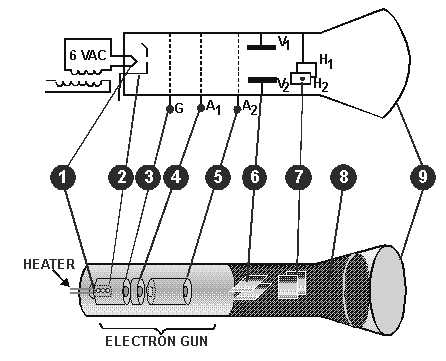2-28
Figure 2-28.—Summary of the CRT.
1. The Heater—serves as the source of heat for the cathode in both the CRT and indirectly heated
tubes.
2. The Cathode—serves as the source of thermionically emitted electrons in both the CRT and
conventional tubes. The major difference is that in the CRT, the cathode is circular in shape and
the outer surface is coated to ensure that electron emission is roughly unidirectional.
3. The Control Grid-in both the CRT and conventional vacuum tubes, the control grid controls the
number of electrons that will be fired across "the gap." The major difference is in the physical
construction. Conventional tubes use a wire-mesh ladder-type grid, while the CRT uses a cap-
like grid.
4. The Focusing Anode—in the CRT, this anode serves a dual purpose of attracting electrons from
the area of the control grid and focusing the electrons into a beam. Its function of attracting
electrons from the area of the grid is similar to the action of the plate in a conventional tube. The
focusing action of the anode is similar to that performed by beam-forming plates in the beam-
forming tetrode. Bear in mind, though, that beam-forming plates are negatively charged and
repel electrons into electron sheets, while the focusing anode is positively charged and attracts
electrons into beam.
5. The Accelerating Anode—in the CRT, this anode is used to accelerate the electrons toward the
front of the tube. Its action is similar to the screen grid of tetrodes and pentodes. But remember,
while the screen grid in conventional tubes accelerates electrons toward the plate, its primary
purpose is to reduce interelectrode capacitance, NOT accelerate electrons.
6. The Vertical-Deflection Plates—in the CRT, these plates move the electron beam up and down
the screen. The input signal is usually applied to these plates. While no equivalent element is

